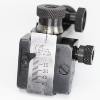My questions relate to durability, ease of use, ease of adjustment, whether an additional front sight is required or desirable regardless.
My Marlin M1894. I put on a big wide, with a white stripe in the middle, front sight. I decided that if I was going to use the thing, I would be better off with a sight that I could pick up in an instant. The bead sights on Marlins, I don't know how good they are in actual hunting situations. The one deer I shot with irons, I used a M27 Finnish Mosin Nagant. It was less than 20 yards, and I only really had time to center the creature between the sight ears and pull the trigger. And it worked great!
I think these Russian battle sights would be just great in short distance, fast acquisition target engagement. Just put the ring on the animal and pull the trigger! Then, use the post if you have the time!

I installed a Williams rear, took it off, installed a modern Lyman, took that off, put the Williams back on.


The problem with the modern Lyman was that the slide is as loose as a goose in the base. I can grab the slide and wiggle it.
When Lyman made a good rear sight, such as this Lyman WJS on my pre 64

That knurled screw in the back

tightens the slide to the base and locks it in. I have shot enough irons to know, a slight bit of wobble translates to huge changes in point of impact. I found this out in spades, when I received back from the Gunsmith, a NM configuration Garand. All the match mods had been done. Load development was disappointing. It shot oval groups, regardless of load. Sent it back to the gunsmith, he said it "shot a group" and sent it back. What constitutes a group can be a point of argument. It was not shooting round, tiny groups. One day, I touched the front sight by accident, and the thing wobbled. Just an itty bitty, tiny amount of wobble. Neither I nor the gunsmith had noticed this, and it is a rookie mistake. I tightened up the lock screw on the bottom of the front sight and the rifle shot great. Lesson learned. A challenge, shoot a 20 shot group out of a Garand, prone with sling, at 200 yards, and do it better. This is with irons.

Now, whenever I am shooting irons, particularly Smallbore Prone, and the call is consistently different from the impact, I reach up and press on the front and rear sights. Ninety nine percent of the time, the sights are tight and the problem is me and my wind judgement. (the lack thereof). But, once a Blue Moon, something is loose. I do the same with my rifle scopes, and you know, I have discovered times when the scope base screws have backed out and the whole mount wobbled. I don't remember which rifles that happened to, but I when I am feeling frisky, I use two part epoxy glue between the scope base and the receiver! Locks the bugger down. The heck with wobbly sights! The screws that held the sight base on the slide of this Kimber backed out, even though I used blue locktite. I cleaned all the mating surfaces and mixed a two part epoxy, lets see how long this takes to come loose.

The Williams sight, it has a standard slotted screw that locks the slide in place. It is a bit of a bugger, you have to have a screwdriver to loosen it, tighten it, because if you don't, the slide is loose in the base. But you know, once I sighted the rifle in, with one load, I did not need to monkey with the thing again.
I think this is an important issue with rear sights, that they are mechanically tight!







